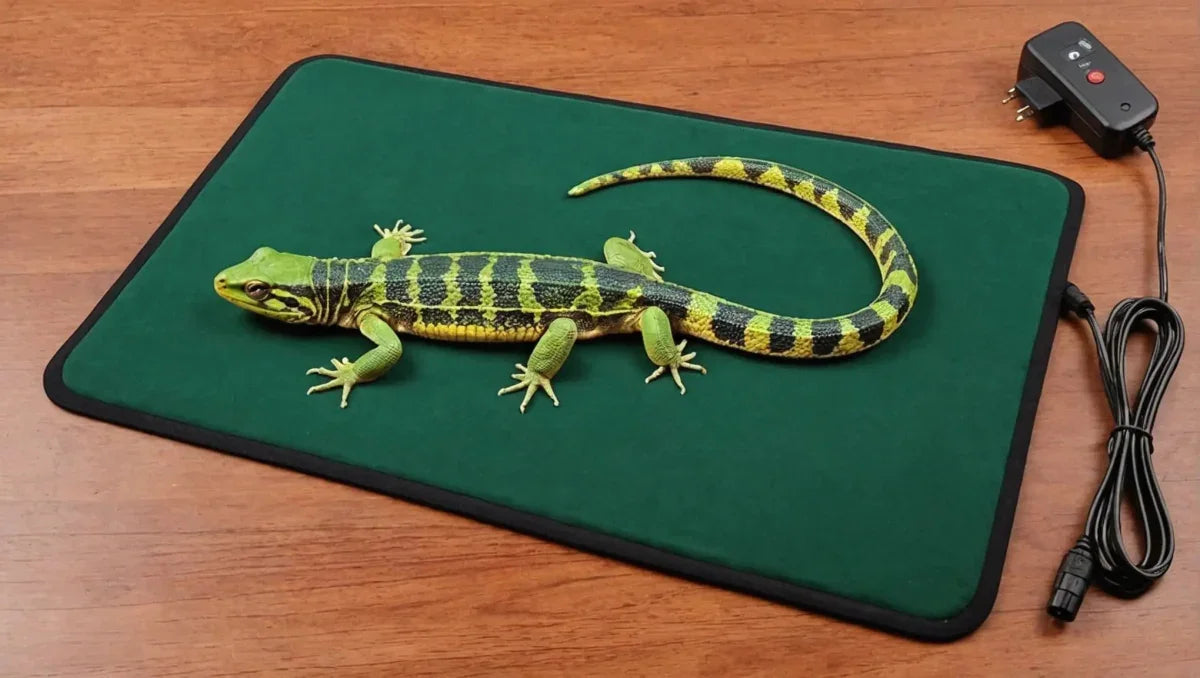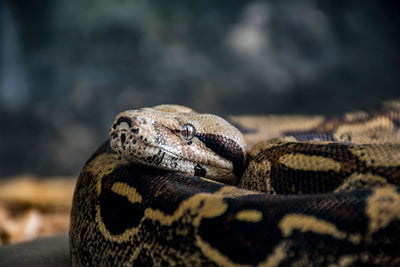
Reptile heating pads are a crucial element in providing the necessary warmth for your scaly companions. These pads mimic the natural warmth reptiles seek in their environment, aiding in digestion, metabolism, and overall well-being. By ensuring the proper temperature gradient in their habitat, you are helping your pet thrive. This essential heat source is particularly vital for reptiles, as they rely on external warmth to regulate their body temperature. In this guide, we will delve into the significance of reptile heating pads and how they contribute to the health and happiness of your beloved pets. Understanding the importance of this heating accessory will enable you to create a comfortable and safe space for your reptile friends. Let's explore the world of reptile heating pads together and discover why they are a must-have for any reptile owner.
Understanding Reptile Heating Pads
How Do Reptile Heating Pads Work?
Reptile heating pads, also known as under-tank heaters, are designed to provide a heat source from beneath the reptile's enclosure. These pads emit a steady, low level of heat to create a warm spot for the reptile to bask and regulate its body temperature. This mimics the warmth they would experience in their natural habitat.
Types of Reptile Heating Pads Available in the Market
- Adhesive Heating Pads : These are attached directly to the bottom of the enclosure.
- Heat Tape : Flexible tape that can be customized to fit various tank sizes.
- Heat Mats : Flat mats that are placed under the tank to provide uniform heating.
- Heat Rocks : Simulate a heated surface for reptiles to rest on.
Factors to Consider When Choosing a Heating Pad for Your Reptile
- Size of the Enclosure : Ensure the heating pad covers the appropriate space for your reptile species.
- Temperature Regulation : Opt for a pad with a thermostat to control and maintain the desired temperature.
- Safety Features : Look for pads with overheating protection and waterproof casing.
- Energy Efficiency : Choose a heating pad that is energy-efficient and cost-effective.
- Compatibility : Check if the heating pad is suitable for the type of reptile you have.
Importance of Proper Heat Regulation for Reptiles
Reptiles are ectothermic, meaning they rely on external sources of heat to regulate their body temperature. Without proper heating, reptiles may suffer from health issues such as poor digestion, weakened immune systems, and lethargy. Heating pads play a crucial role in providing the necessary warmth for reptiles to thrive.
Monitoring and Maintaining Heat Levels
It is essential to monitor the temperature within the enclosure regularly. Use a thermometer to ensure that the heat pad is maintaining the correct temperature gradient suitable for your reptile species. Adjust the heating pad settings as needed to create optimal basking spots and cooler zones within the habitat.
Seasonal Considerations
During colder months, reptiles may require additional heating to offset lower room temperatures. Supplemental heating sources like ceramic heat emitters or heat lamps can be used in conjunction with heating pads to maintain consistent warmth. Be cautious not to overheat the enclosure, as this can be harmful to your pet.
Consulting with a Reptile Specialist
If you are unsure about the heating requirements for your specific reptile species, consider consulting with a reptile veterinarian or specialist. They can provide guidance on selecting the right heating pad, setting up temperature gradients, and ensuring a comfortable environment for your reptile's well-being.
Understanding the nuances of reptile heating pads and implementing proper heat management practices are integral to creating a safe and comfortable habitat for your pet reptile. By prioritizing heat regulation, you contribute to the overall health and vitality of your scaly companion.
Setting Up the Heating Pad
Step-by-Step Guide on How to Properly Set Up a Reptile Heating Pad in the Enclosure
When setting up a heating pad for your reptile enclosure, it is essential to follow these steps to ensure the safety and well-being of your pet:.
-
Selecting the Right Size: Choose a heating pad that fits the size of your enclosure. It should cover only a portion of the tank to provide a temperature gradient.
-
Placement: Install the heating pad on the exterior bottom of the enclosure. Make sure it is placed on one side to create a warm area while leaving the other side cooler for your reptile to regulate its body temperature.
-
Thermostat Installation: Connect the heating pad to a thermostat to regulate the temperature. This will prevent overheating and ensure a consistent warmth level.
-
Monitoring Temperature: Use a thermometer to monitor the temperature regularly. Adjust the thermostat settings as needed to maintain the ideal temperature range for your reptile's species.
Tips for Monitoring and Adjusting the Temperature
-
Regular Checks: Monitor the temperature inside the enclosure at different times of the day to ensure it remains within the recommended range.
-
Behavior Observation: Watch your reptile's behavior to determine if they are comfortable. If they spend too much time on the heating pad or avoid it completely, adjustments may be necessary.
-
Seasonal Changes: Be aware of external factors that can affect the temperature, such as changes in weather or seasons. Adjust the thermostat settings accordingly.
Importance of Proper Heating
Proper heating is crucial for reptiles as they are ectothermic creatures, relying on external heat sources to regulate their body temperature. Inadequate heating can lead to health issues like poor digestion, lethargy, and even death in extreme cases. By setting up a heating pad correctly, you provide your reptile with the necessary warmth to thrive.
Creating a Thermal Gradient
A heating pad should only cover a portion of the enclosure to create a thermal gradient. This gradient allows your reptile to move between warmer and cooler areas to regulate its body temperature effectively. Without this gradient, your reptile may struggle to find the right temperature to maintain its health.
Additional Temperature Monitoring Tools
In addition to a thermometer and thermostat, consider using a temperature gun to spot-check various areas in the enclosure. This tool provides instant readings and can help you identify any hot or cold spots that may need adjustment.
Safety Precautions
When setting up a heating pad, ensure it is securely attached to the enclosure to prevent accidental detachment. Avoid placing any substrate directly on top of the heating pad to prevent overheating or fire hazards. Regularly inspect the pad for any signs of wear or damage to maintain a safe heating environment for your reptile.
By following these additional tips and information, you can enhance the effectiveness of your heating pad setup and ensure the comfort and well-being of your reptile companion.
Benefits of Proper Heating
Positive Impact on Reptile Health
Maintaining optimal heat levels is crucial for the overall health and well-being of reptiles. Adequate heat not only aids in digestion and supports metabolic functions but also plays a significant role in boosting the immune system of reptiles. When reptiles are exposed to proper heating conditions, they are less likely to suffer from health issues like poor digestion, slow metabolism, and weakened immunity, ensuring a longer and healthier life.
Enhancing Activity with Heating Pads
Heating pads serve as essential equipment for creating a comfortable and stimulating environment for reptiles. By providing a consistent source of warmth, heating pads enable reptiles to regulate their body temperature effectively. This regulation is vital for facilitating essential physiological processes and encouraging physical activities such as movement, feeding, and exploration. With the aid of heating pads, reptiles can exhibit their natural behaviors more actively, promoting mental stimulation and overall vitality.
Behavioral Enrichment through Proper Heating
Proper heating not only influences the physical health of reptiles but also plays a crucial role in shaping their behavior. Reptiles thrive in environments with suitable heating conditions as they mimic their natural habitats. The availability of warmth encourages reptiles to engage in instinctual behaviors like basking under heat lamps, hunting for food, and exploring their surroundings. These activities are not only essential for their physical health but also contribute to their mental well-being and overall happiness.
Significance of Temperature Regulation
Temperature regulation is a cornerstone of reptile care, especially since reptiles rely on external heat sources to maintain their body temperature. Inconsistencies in heating can lead to stress, lethargy, and other health complications in reptiles. By incorporating heating pads and other heating elements, reptile owners can create a controlled and comfortable environment that supports their pets' physiological and behavioral needs. Maintaining proper heat levels is fundamental in ensuring that reptiles thrive in captivity and exhibit natural behaviors.
Conclusion
Prioritizing proper heating for reptiles goes beyond mere comfort; it is a crucial component of responsible reptile care. By understanding the importance of maintaining optimal heat levels, providing suitable heating solutions, and creating a stimulating environment, reptile enthusiasts can significantly enhance the well-being and quality of life of their scaly companions. Investing in proper heating not only benefits the physical health of reptiles but also enriches their behavioral repertoire, ensuring that they lead fulfilling lives in captivity.
Common Mistakes to Avoid
-
Not using a cover: Using a heating pad directly on a pet's skin can cause burns. It is essential to always place a cover or a towel between the heating pad and the pet to prevent any skin damage.
-
Overheating: Leaving the heating pad on for too long or at a high temperature can lead to overheating the pet. It is crucial to follow the recommended heating durations and temperature settings to ensure the pet's safety and comfort.
-
Incorrect placement: Placing the heating pad in the wrong area can cause discomfort or injury to the pet. Always place the heating pad in areas recommended by veterinarians, such as the pet's bed or a designated spot, to avoid any potential harm.
-
Using a damaged heating pad: Using a heating pad with frayed wires or other damage can be hazardous. Regularly inspect the heating pad for any signs of wear and tear, and replace it if any damage is detected to prevent accidents.
-
Ignoring manufacturer instructions: Not following the guidelines provided by the heating pad manufacturer can result in misuse. It is crucial to read and adhere to the manufacturer's instructions for the proper use and maintenance of the heating pad to ensure the pet's safety.
Potential Risks of Improper Use of Heating Pads
-
Burns: Direct contact with a heating pad can cause burns on a pet's skin. Always use a barrier between the heating pad and the pet to prevent burns and skin irritation.
-
Overheating: Prolonged exposure to high temperatures can lead to overheating and heat stress in pets. Monitoring the heating pad's temperature and duration of use is vital to prevent overheating and discomfort for the pet.
-
Electric shock: A damaged heating pad can pose a risk of electric shock to both the pet and the owner. Inspect the heating pad regularly for any signs of damage and discontinue use if any issues are found to avoid electrical hazards.
-
Fire hazard: Overheating or using a faulty heating pad can increase the risk of a fire in the home. Always follow safety precautions and never leave the heating pad unattended while in use to prevent fire accidents.
-
Reduced efficacy: Improper use of heating pads may reduce their effectiveness in providing comfort or relief to pets. Following proper usage guidelines and maintenance instructions can help ensure the heating pad functions optimally and benefits the pet as intended.
When using heating pads for pets, always prioritize safety and comfort to provide them with the warmth and relief they need, while avoiding the common mistakes that can lead to potential risks and harm.
Conclusion
A reptile heating pad is an essential accessory for ensuring the well-being and comfort of your pet reptile. By providing a consistent source of heat, heating pads help regulate the temperature gradient within the reptile enclosure, which is crucial for the overall health, digestion, and activity levels of your scaly companion. Investing in a quality heating pad and using it correctly can make a significant difference in the happiness and longevity of your pet reptile.






